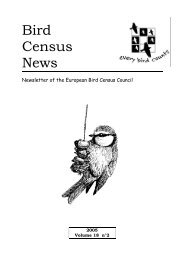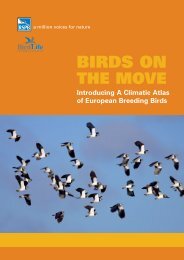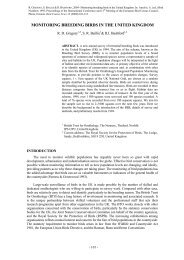Quantifying the impact of land-use change to European farmland ...
Quantifying the impact of land-use change to European farmland ...
Quantifying the impact of land-use change to European farmland ...
Create successful ePaper yourself
Turn your PDF publications into a flip-book with our unique Google optimized e-Paper software.
356 S.J. Butler et al. / Agriculture, Ecosystems and Environment 137 (2010) 348–357<br />
money it allocates <strong>to</strong> AES specifically exists. Fur<strong>the</strong>rmore, at <strong>the</strong><br />
scale <strong>of</strong> <strong>the</strong>se analyses, we cannot pass judgement on <strong>the</strong> effectiveness<br />
<strong>of</strong> <strong>the</strong> design and implementation <strong>of</strong> schemes within each<br />
country. However, we believe that increased recognition <strong>of</strong> <strong>the</strong> differences<br />
in <strong>the</strong> relative contribution <strong>of</strong> countries <strong>to</strong> <strong>the</strong> EFBI and<br />
<strong>the</strong> likely scale <strong>of</strong> <strong>the</strong> response <strong>of</strong> farm<strong>land</strong> bird populations <strong>to</strong><br />
environmentally-beneficial management in <strong>the</strong> allocation <strong>of</strong> Pillar<br />
2 funds both between and within countries will contribute <strong>to</strong> <strong>the</strong><br />
cost-effective and efficient delivery <strong>of</strong> <strong>the</strong> EU’s Rural Development<br />
strategy. In particular, our results suggest that additional funding<br />
for AES in Spain and Hol<strong>land</strong>, whe<strong>the</strong>r through an increase in <strong>the</strong><br />
overall allocation <strong>of</strong> Pillar 2 funds or via a national re-distribution<br />
<strong>of</strong> existing Pillar 2 money between <strong>the</strong> four Axes, would be particularly<br />
beneficial.<br />
4.2. Model assumptions and data limitations<br />
Trait-based frameworks have successfully been <strong>use</strong>d <strong>to</strong> assess<br />
<strong>the</strong> <strong>impact</strong> <strong>of</strong> agricultural <strong>change</strong> on a range <strong>of</strong> taxonomic groups,<br />
including farm<strong>land</strong> birds, arable broadleaf plants and bumblebees<br />
at a national level (Butler et al., 2007, 2009). The pan-<strong>European</strong><br />
approach reported here relies fundamentally on <strong>the</strong> same principle<br />
as <strong>the</strong>se models, i.e. that <strong>the</strong> <strong>impact</strong> <strong>of</strong> a given <strong>change</strong> on a<br />
given species can be quantified by assessing <strong>the</strong> proportion <strong>of</strong> <strong>the</strong><br />
species’ key resource requirements detrimentally affected by that<br />
<strong>change</strong>. However, <strong>to</strong> work at a continental ra<strong>the</strong>r than a national<br />
scale we had <strong>to</strong> both broaden existing assumptions and make a<br />
number <strong>of</strong> additional ones. These reveal key data limitations and<br />
areas requiring fur<strong>the</strong>r research that are discussed in detail below.<br />
Firstly, whilst we allowed each species’ reliance on farm<strong>land</strong> <strong>to</strong><br />
provide <strong>the</strong>ir key resources <strong>to</strong> vary between countries, we assumed<br />
that <strong>the</strong> set <strong>of</strong> resource requirements identified for each species was<br />
appropriate for all countries. Whilst it is possible that <strong>the</strong>re is some<br />
intra-species variation in, for example, diet composition between<br />
countries, this is likely <strong>to</strong> operate at a much finer scale <strong>of</strong> detail than<br />
<strong>the</strong> broad categories <strong>of</strong> resource requirements defined in our risk<br />
assessment framework and <strong>the</strong>refore will not significantly influence<br />
<strong>the</strong> results presented. Due <strong>to</strong> a paucity <strong>of</strong> data for some species,<br />
migration strategies for non-resident species that over-winter in<br />
Europe were also defined relatively coarsely; wintering locations<br />
were identified <strong>to</strong> a regional level and it was assumed that <strong>the</strong><br />
breeding population from a given country was distributed between<br />
<strong>the</strong> over-wintering regions identified and between <strong>the</strong> constituent<br />
countries within each over-wintering region on <strong>the</strong> basis <strong>of</strong> farmed<br />
<strong>land</strong> area. Whilst we believe this assumption is justified for <strong>the</strong><br />
analyses presented here, fur<strong>the</strong>r research <strong>to</strong> accurately identify <strong>the</strong><br />
wintering location <strong>of</strong> <strong>the</strong> breeding populations <strong>of</strong> all species in each<br />
country would allow more accurate predictions <strong>to</strong> be made.<br />
It is important <strong>to</strong> note that our assessment <strong>of</strong> <strong>the</strong> <strong>impact</strong> <strong>of</strong> past<br />
agricultural intensification and <strong>land</strong> abandonment during <strong>the</strong> validation<br />
<strong>of</strong> both <strong>the</strong> BASIC and SCALE frameworks foc<strong>use</strong>d solely on<br />
<strong>the</strong> biodiversity risks <strong>of</strong> <strong>land</strong>-<strong>use</strong> and management <strong>change</strong>s and did<br />
not take in<strong>to</strong> account any potential benefits <strong>to</strong> biodiversity associated<br />
with <strong>the</strong>se <strong>change</strong>s (Robinson et al., 2001). Fur<strong>the</strong>rmore, <strong>the</strong><br />
structure <strong>of</strong> <strong>the</strong> BASIC framework assumes that, within a country,<br />
<strong>the</strong> entire population <strong>of</strong> each species is exposed <strong>to</strong> <strong>the</strong> <strong>impact</strong>s<br />
<strong>of</strong> each <strong>change</strong> assessed and also that <strong>the</strong> scale and <strong>impact</strong> <strong>of</strong><br />
each <strong>change</strong> on resource availability has been <strong>the</strong> same between<br />
countries. However, <strong>the</strong> timing and scale <strong>of</strong> agricultural <strong>change</strong><br />
can vary both between and within countries, driven by policy<br />
reform, technological advances, socio–economic and environmental<br />
fac<strong>to</strong>rs (Mattison and Norris, 2005). The SCALE framework<br />
overcomes <strong>the</strong>se limitations <strong>to</strong> some extent by accounting for<br />
regional variation in <strong>the</strong> scale <strong>of</strong> agricultural intensification and<br />
<strong>land</strong> abandonment but <strong>the</strong>re are currently insufficient data available<br />
<strong>to</strong> make country- and <strong>change</strong> component-specific adjustments<br />
for <strong>the</strong> scale and intensity <strong>of</strong> <strong>change</strong>s. Despite <strong>the</strong>se assumptions,<br />
we were able <strong>to</strong> accurately predict <strong>the</strong> current level <strong>of</strong> EFBI using<br />
our model, suggesting that it captures <strong>the</strong> key mechanisms driving<br />
population dynamics in <strong>European</strong> farm<strong>land</strong> bird populations.<br />
Including a scaling fac<strong>to</strong>r did not alter <strong>the</strong> predictive capability <strong>of</strong><br />
<strong>the</strong> SCALE framework compared <strong>to</strong> <strong>the</strong> BASIC framework, probably<br />
due <strong>to</strong> <strong>the</strong> coarseness <strong>of</strong> <strong>the</strong> scaling fac<strong>to</strong>r we had <strong>to</strong> <strong>use</strong>, but<br />
<strong>the</strong> parallel development <strong>of</strong> both frameworks allows <strong>the</strong> potential<br />
<strong>impact</strong>s <strong>of</strong> a greater range <strong>of</strong> <strong>land</strong>-<strong>use</strong> and management <strong>change</strong>s<br />
<strong>to</strong> be assessed. Future developments <strong>of</strong> this approach <strong>to</strong> reflect<br />
within- and between-country differences are likely <strong>to</strong> improve <strong>the</strong><br />
accuracy <strong>of</strong> model predictions.<br />
5. Conclusions<br />
Whilst not all AES are designed with biodiversity protection as<br />
<strong>the</strong>ir fundamental goal, it is ei<strong>the</strong>r one <strong>of</strong> multiple objectives or <strong>the</strong><br />
principle objective <strong>of</strong> many schemes. These schemes are currently<br />
<strong>the</strong> main policy <strong>to</strong>ol for mitigating <strong>the</strong> detrimental environmental<br />
<strong>impact</strong>s <strong>of</strong> modern agriculture and for delivering <strong>the</strong> resources<br />
on which farm<strong>land</strong> biodiversity relies back in<strong>to</strong> agricultural <strong>land</strong>scapes.<br />
We demonstrate that a trait-based approach can be <strong>use</strong>d <strong>to</strong><br />
quantify <strong>the</strong> <strong>impact</strong>s <strong>of</strong> <strong>land</strong>-<strong>use</strong> and management <strong>change</strong> on farm<strong>land</strong><br />
birds, frequently <strong>use</strong>d as a proxy for wider biodiversity, at a<br />
pan-<strong>European</strong> scale. By identifying <strong>the</strong> key drivers <strong>of</strong> population<br />
<strong>change</strong> in agricultural <strong>land</strong>scapes and <strong>the</strong> relative contribution <strong>of</strong><br />
each country <strong>to</strong> <strong>the</strong> level <strong>of</strong> EFBI, our results can be <strong>use</strong>d <strong>to</strong> guide<br />
both <strong>the</strong> development and implementation <strong>of</strong> targeted AES and <strong>the</strong><br />
objective distribution <strong>of</strong> Pillar 2 funds between and within Member<br />
States. We hope that this will contribute <strong>to</strong> <strong>the</strong> cost-effective and<br />
efficient delivery <strong>of</strong> Rural Development strategy and biodiversity<br />
conservation targets.<br />
Acknowledgements<br />
The following people provided species reliance scores: Ainars<br />
Aunins, Chris Bailey, Stuart Benn, Richard Bradbury, Brian Caffrey,<br />
Kenna Chisholm, Koen Devos, Ian Dillon, Paul Donald, Virginia<br />
Escandell, Rob Field, Martin Flade, Ruud Foppen, Lorenzo Fornasari,<br />
Derek Gruar, Marco Gustin, Mark Hancock, Henning Heldbjerg,<br />
Sergi Herrando, Magne Husby, Frédéric Jiguet, Marek Jobda, Will<br />
Kirby, Jaroslaw Krogulec, Lars Lachmann, Monika Laurits, Domingos<br />
Leitão, Hywel Maggs, Riho Marja, Ricardo Martins, Oscar<br />
Merne, Pete Moore, Tony Morris, Szabolcs Nagy, Ivar Ojaste, James<br />
Pearce-Higgins, Allan Perkins, Janis Priednieks, João Rabaça, Goetz<br />
Rheinwald, Jiri Reif, Hans Schmid, Martin Scott, Rosemary Setchfield,<br />
Henk Sierdsema, Karel Stastny, Sören Svensson, Juha Tiainen,<br />
Norbert Teufelbauer, Ris<strong>to</strong> Väisanen, Chris van Turnhout, Zdenek<br />
Vermouzek, Zoltan Waliczky, Richard Winspear, Will Woodrow.<br />
Thanks <strong>to</strong> <strong>the</strong> individuals and organisations responsible for national<br />
trend data collection and analysis; Norbert Teufelbauer, Michael<br />
Dvorak, Christian Vansteenwegen, Anne Weiserbs, Jean-Paul Jacob,<br />
Anny Anselin, Thierry Kinet, An<strong>to</strong>ine Derouaux, Sve<strong>to</strong>slav Spasov,<br />
Jiˇrí Reif, Henning Heldbjerg, Michael Grell, Andres Kuresoo, Jaanus<br />
Elts, Ris<strong>to</strong> A. Väisänen, Fréderic Jiguet, Johannes Schwarz, Martin<br />
Flade, Tibor Szep, Olivia Crowe, Dick Coombes, Lorenzo Fornasari,<br />
Elisabetta de Carli, Ainars Aunins, Ruud P. B. Foppen, Magne<br />
Husby, Przemek Chylarecki, Barbara Archita, Ge<strong>of</strong>f Hil<strong>to</strong>n, Ana<br />
Meirinho, Juan Carlos del Moral, Ramón Martí, Virginia Escandell,<br />
Åke Lindström, Sören Svensson, Hans Schmid, David G. Noble,<br />
Mike Raven and Andrew Joys. Thanks also <strong>to</strong> Jana ˇSkorpilová,<br />
Alena Klvaňová, Arco van Strien, Adriaan Gmelig Meyling, Tomáˇs<br />
Telensk ´y, Ian Burfield, Fiona Sanderson, Paul Donald, Gareth Morgan,<br />
Norbert Schaffer, Sue Armstrong-Brown, David W. Gibbons<br />
and Anne Teller for assistance and support. The PECBMS is sup-






